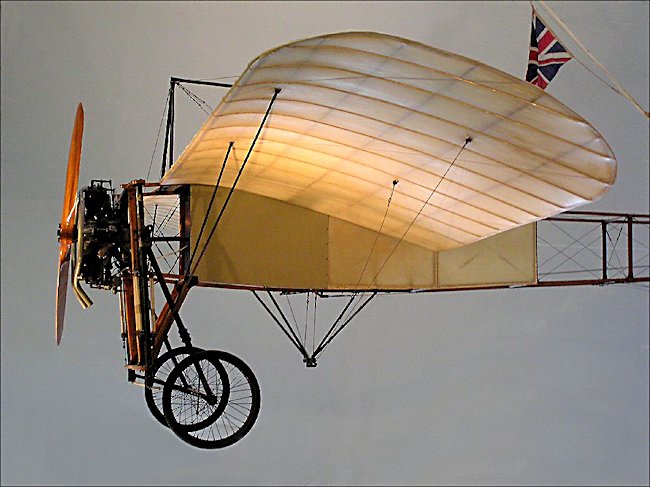RFC Bleriot WW1 reconnaissance monoplane
Louis Bleriot made nine variants of the Bleriot Monoplane until with the help of engineer Raymond Saulnier, the Bleriot XI Monoplane took to the skies for the first time at Issy-les-Moulineaux on 23rd January 1909. The Bleriot Monoplane became famous when the plane and its French designer, Louis Bleriot, made the first aerial crossing of the English Channel 25th July 1909 successfully crossed the English Channel from Calais to Dover in 36.5 minutes. He had to fight fog and bad weather without a compass to guide his crossing.
It was reported at the time that the plane only made the flight with the aid of a brief rain shower to cool off the hot engine. Bleriot also let the aircraft guide towards the English coast. he spotted a French reporter waving the French flag marking the landing spot. He made a very rough "pancake" landing during which the landing gear collapsed, but he walked away, winning the £1,000 prize awarded by the Daily Mail news paper.

Photograph taken at the RAF Museum, Hendon, London NW9 5LL England
Bleriot received orders for 101 Bleriot XI monoplane aircraft after the successful crossing. He began to turn his attention from flying to the aircraft manufacturing business. By 1913, Louis Bleriot's factories had delivered no less than 800 examples of the Bleriot XI, an amazing production run for the time, especially for an aircraft priced at about $5,000 which was a lot of money in 1913. It was constructed of oak and poplar wood and the flying surfaces were covered with cloth.
Later versions of the Bleriot XI used different engines including more powerful Gnome rotary engines and updated Anzani engines. He marketed the aircraft in various categories: trainers, sport or touring models, military aircraft, and racing or exhibition machines. The Bleriot XI was one of the first dependable, reliable and versatile monoplanes at a time when many of its contemporaries were dangerous, difficult to control and unstable in an aviation world populated by increasing numbers of biplanes.
In Libya in 1911 the Italian army's Bleriot XI Monoplanes were the first aircraft ever to see combat during the Italo-Turkish War (1911-12). It was also used in the First and Second Balkan Wars (1912-13). The rear passenger seat was fitted with a machine gun and 25kg bombs could be thrown over the side of the plane.
The Royal Flying Corps received its first Bleriot XI in 1912. When World War One started the RFC purchased an extra 23 Bleriot XI's. They were taken over to the Western Front in France and used them as battlefield observation and reconnaissance aircraft. Six RFC squadrons were equipped with Bleriot XI monoplane. Eight French Service de l'Aviation squadrons or escadrilles were equipped with Bleriot XI monoplane. Italy during world war one was on the side of the Allies and also flew Bleriot XI's in six of its squadrons. Some Bleriot XI monoplane were also operated by the Royal Naval Air Service, Belgian, Russian and Serbian forces. The Bleriot XI quickly became obsolete and was soon relegated to less demanding roles and training squadrons.
Bleriot WW1 aircraft books


Tweet